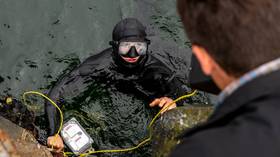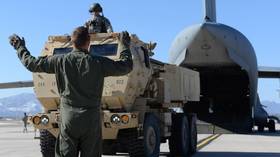Buzzwords= IMPLAUSIBLE DENIABILITY
More information is needed before it will be possible to say who is behind the incident, the US defense secretary has said
It is too early to speculate about who is responsible for the gas leaks in the Nord Stream pipelines, US Secretary of Defense Lloyd Austin said on Friday, adding that a full investigation into the matter must be carried out.
Speaking at a press conference in Hawaii, the Pentagon chief declined to blame anyone for the incident involving the Russian gas pipelines.
“In terms of the attack – or the damage to the pipeline, at this point I think there’s a lot of speculation,” and until a complete investigation is done, no one will be able to say for certain what happened, he said.
Austin noted that he discussed the leaks with his Danish counterpart, given that the incident took place near the island of Bornholm, Denmark, adding that it will take the Danes several days to “get the right team in to look at the sites and really try to determine … what happened.”
“Until we get further information, or are able to do further analysis, we won’t speculate on who may have been responsible,” he reiterated, signaling that the US has offered to provide assistance.
On Monday, Denmark reported leaks from the pipelines which connect Germany and Russia under the Baltic Sea, after the operator reported a loss of pressure in both Nord Stream 1 and 2. The Danish and Swedish authorities later said they had detected a series of undersea explosions near Bornholm. In total, there have been four gas leaks in the Nord Stream system.
Some Western officials have said the incident may have been caused by sabotage, a statement largely echoed by Kremlin Press Secretary Dmitry Peskov, who described the leaks as a probable “terrorist act” which was unlikely to have been possible “without the involvement of some state power.”
Officials from both sides have reserved judgement on who is to blame for the incident.
Germany
has reportedly been investigating the leaks as an attack, carried out
either by pro-Ukrainian forces or Russia itself in a potential
false-flag operation to make Kiev look bad.
On Thursday, Russian Foreign Ministry spokeswoman Maria Zakharova dismissed allegations that Russia was behind the incident. She noted that this summer, NATO was engaged in military activities close to the location where the leaks were found, adding that it might have presented an interesting “opportunity” for the bloc.
Zakharova also urged Washington to offer an explanation and “confess” to the truth, saying that the US had left that job to former Polish Foreign Minister Radoslaw Sikorski, who, in a now-deleted tweet, ‘thanked’ the US for destroying the pipeline."
✓
The new military unit will reportedly be modeled on “train-and-assist efforts in Iraq and Afghanistan” over the last 20 years
The Pentagon is working to create a new military command devoted to arming and training Ukrainian soldiers, US officials have told multiple media outlets, suggesting the effort will effectively “overhaul” the current process for weapons transfers to Kiev.
The command would be based in Wiesbaden, Germany – where the US Army keeps its European headquarters – and be made up of 300 staffers led by General Christopher Cavoli, who heads up the military’s European Command, according to unnamed officials cited by the New York Times and CNN on Thursday.
“The changes, which aim to give a formal structure to what has been improvised since the war’s onset, are roughly modeled on US train-and-assist efforts in Iraq and Afghanistan over the past two decades,” the Times reported.
While the new unit would look to make major alterations to the current train-and-equip program for Kiev, Wiesbaden will remain a key component in the scheme, as most Ukrainian troops currently being instructed on American weapons are doing so in or near the city.
Since Russia sent troops into the neighboring country in late February, US military aid to Ukraine has largely been managed from Germany and Poland by Lieutenant General Christopher Donahue, who also oversaw the chaotic evacuation of US forces from Afghanistan last year. However, Donahue and his staff are set to return home next month, creating the need for a specialized command oriented toward training and arming Ukrainian troops.
The proposal for the new unit was initially floated earlier in the conflict by General Tod Wolters, with Cavoli ‘fine-tuning’ the idea after taking his place at EUCOM in July, according to the Times.
In late August, the Wall Street Journal similarly reported that Washington was looking to appoint a general to lead the arm-and-train program in Ukraine, suggesting the initiative could receive an official mission name, as well as “long-term, dedicated funding” from the US government. The outlet added that the changes would mark a “shift from the largely ad hoc effort to provide training and assistance to the Ukrainians for years.”
The US has authorized nearly $17 billion in arms transfers to Ukraine’s military so far this year, with the vast majority of that aid approved since hostilities escalated in February. Though large quantities of gear and ammunition have come directly from existing stockpiles, the Pentagon is also working with arms contractors to manufacture weapons specifically for Kiev, including 18 brand-new High Mobility Artillery Rocket Systems (HIMARS) announced earlier this week – one of the longest-range platforms provided by Washington to date."








No comments:
Post a Comment